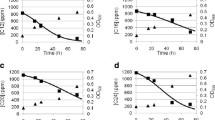Summary
A Rhodococcus species, designated strain UW1, was isolated from contaminated soil using conventional enrichment and isolation techniques. The isolate was able to use pyrene as sole source of carbon and energy; it mineralized 72% of the pyrene within 2 weeks. During growth a metabolite was detected in the culture fluid and further characterized by UV- and mass spectrometry. There is evidence that this metabolite resulted from a recyclization of the direct meta-ring-fission product of pyrene after dihydroxylation in either the 1,2- or 4,5-position. At pH 7.0 and 30°C Rhodococcus sp. UW1 showed a maximum degradation rate of 0.08 mg pyrene/ml per day, while growing with a doubling time of 30 h. The activity of the initial dioxygenase system was characterized by measuring the oxygen-consumption rates of pyrene-induced resting cells, the maxima of which occurred at pH 7.2 and 45°C. Rhodococcus sp. UW1 could also use phenathrene, anthracene, fluoranthene and chrysene as sole sources of carbon and energy, whereas naphthalene, dibenzofuran, fluorene and dibenzothiophene were only co-metabolized.
Similar content being viewed by others
References
Barnsley EA (1976) Naphthalene metabolism by pseudomonads: the oxidation of 1,2-dihydroxynapthalene to 1,2-dihydroxychromene-2-carboxylic acid and the formation of 2′-hydroxybenzalpyruvate. Biochem Biophys Res Commun 72:1116–1121
Bauer JE, Capone DC (1985) Degradation and mineralization of the polycyclic aromatic hydrocarbons anthracene and naphthalene in intertidal marine sediments. Appl Environ Microbiol 50:81–90
Cain RB (1981) Regulation of aromatic and hydroaromatic catabolic pathways in nocardioform actinomycetes. Zentralbl Bakteriol Mikrobiol Hyg I Abt Orig, Suppl 11:335–354
Cerniglia CE (1984) Microbial metabolism of polycyclic aromatic hydrocarbons. Adv Appl Microbiol 30:31–71
Codner RC (1969) Solid and solidified growth media in microbiology. Methods Microbiol 427–454
Eggeling L, Sahm H (1981) Degradation of lignin-related aromatic compounds by Nocardia spec. DSM 1069 and specificity of demethylation. Zentralbl Bacteriol Mikrobiol Hyg I Abt Orig, Suppl 11:361–366
Evans WC, Fernley HN, Griffith E (1965) Oxidative metabolism of phenanthrene and anthracene by soil pseudomonads. Biochem J 95:819–831
Fujisawa H (1970) Protocatechuate-3,4-dioxygenase (pseudomonads). Methods Enzymol 17A:526–529
Gibson TD (1984) Microbial degradation of organic compounds. Dekker, New York
Heitkamp MA, Franklin W, Cerniglia CE (1988a) Microbial metabolism of polycyclic aromatic hydrocarbons: isolation and characterization of a pyrene-degrading bacterium. Appl Environ Microbiol 54:2549–2555
Heitkamp MA, Fremann JP, Miller DW, Cerniglia CE (1988b) Pyrene degradation by a Mycobacterium sp.: identification of ring oxidation and ring fission products. Appl Environ Microbiol 54:2556–2565
Hites RA, Laflamme RF, Windsor JG (1980) Polycyclic aromatic hydrocarbons in marine/aquatic sediments: their ubiquity. In: Petrakis L, Weiss FT (eds) Petroleum in the marine environment. (Advances in chemistry series) American Chemical Society, Washington, D.C., pp 289–311
Jacob J, Karcher W, Belliando JJ, Wagstaffe PJ (1986) Polycyclic aromatic hydrocarbons of environmental and occupational importance. Fresenius Z Anal Chem 323:1–10
Kirk KT, Schultz E, Connors WJ, Lorenz LF, Zeikus JG (1978) Influence of culture parameters on lignin metabolism by Phanerochaete chrysosporium. Arch Microbiol 117:277–285
Lowry OH, Rosebrough NJ, Farr AL, Randall RJ (1951) Protein measurement with the Folin phenol reagent. J Biol Chem 193:265–275
Mahaffey WR, Gibson DT, Cerniglia CE (1988) Bacterial oxidation of chemical carcinogens: formation of polycyclic aromatic acids from benz(a)anthracene. Appl Environ Microbiol 54:2415–2423
Mortelmans K, Wawarth S, Lawlor T, Speck W, Tainer B, Zeiger E (1986) Salmonella mutagenicity tests. II. Results from the testing of 270 chemicals. Environ Mutagen 8:1–119
Mueller JG, Chapman PJ, Pritchard PH (1989) Action of a fluoranthene-utilizing bacterial community on polycyclic aromatic hydrocarbon components of creosote. Appl Environ Microbiol 55:3085–3090
Mueller JG, Chapman PJ, Blattmann BO, Pritchard PH (1990) Isolation and characterization of a fluoranthene-utilizing strain of Pseudomonas paucimobilis. Appl Environ Microbiol 56:1079–1086
National academy of Science (1983) Polycyclic aromatic hydrocarbons: evaluation of sources and effects. National Academy Press, Washington, D.C.
Nesterenko OA, Kasumowa SA, Kvasnikov EI (1978) Microorganisms of the Nocardia genus and the ‘rhodochrous’ group in soils of the Ukranian SSR. Mikrobiologiya 47:866–870
Patel TR, Barnsley EA (1980) Naphthalene metabolism by pseudomonads: purification and properties of 1,2-dihydroxynaphthalene oxygenase. J Bacteriol 143:668–673
Pahlmann R, Pelkonen O (1987) Mutagenicity studies of different polycyclic aromatic hydrocarbons: the significance of enzymatic factors and molecular structures. Cardinogenesis. 8:773–778
Pfennig N, Lippert KD (1966) Über das Vitamin-B-12-Bedürfnis phototropher Schwefelbakterien. Arch Microbiol 55:245–256
Rast HG, Engelhardt D, Diegler W, Wallhoffer PR (1980) Bacterial degradation of model compounds for lignin and chlorophenol derived lignin bound residues. FEMS Microbiol Lett 8:259–263
Strandberg GW, Abraham TJ, Frazier GC (1986) Phenanthrene degradation by Beijerinckia sp. B8/36. Biotechnol Bioeng 28:142–145
Straube G, Hensel J, Niedan C, Straube E (1990) Kinetic studies of phenol degradation by Rhodococcus sp. P1 I. Batch cultivation. Antonie van Leeuwenhoek 57:29–32
Tarnok I (1976) Metabolism in Nocardiae and related bacteria. In: Goodfellow, Brownell, Serrano (eds) Biology of Nocardiae. Academic Press, New York, pp 451–500
Weissenfels WD, Beyer M, Klein J (1990) Degradation of phenanthrene, fluorene and fluoranthene by pure bacterial cultures. Appl Microbiol Biotechnol 32:479–484
White KL (1986) An overview of immunotoxicology and carcinogenic polycyclic aromatic hydrocarbons. Environ Carcinogen Rev C4:163–202
Author information
Authors and Affiliations
Additional information
Offprint requests to: U. Walter
Rights and permissions
About this article
Cite this article
Walter, U., Beyer, M., Klein, J. et al. Degradation of pyrene byRhodococcus sp. UW1. Appl Microbiol Biotechnol 34, 671–676 (1991). https://doi.org/10.1007/BF00167921
Received:
Accepted:
Issue Date:
DOI: https://doi.org/10.1007/BF00167921




